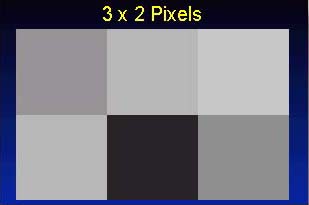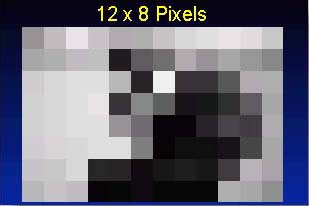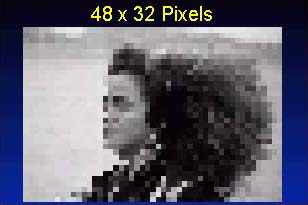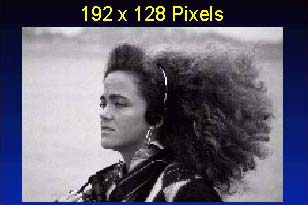Paul R. Montague, CRA FOPS
Department of Ophthalmology and Visual Sciences
The Univesity of Iowa Hospitals and Clinics
Iowa City, Iowa
Imaging with film and digital imaging are vastly different technologies which may appear on the surface to produce similar results. In order to make meaningful comparisons, it is necessary to have some understanding of each.
There are about 86,400,000,000 sliver halide crystals in a 35mm photographic image. When one of these silver halide crystals is struck by a photon of light, a tiny spec of solid silver is formed. More light creates more specs of solid silver, none of which can be seen by the naked eye. When the film is exposed in a camera, dark areas in the scene produce few silver specs, and lighter areas produce more silver specs, creating a latent image on the film.
Once a latent image has been captured on the film, it is placed in a liquid developer which reduces the silver halide to metallic silver. Because the development reaction is strongly catalyzed by the presence of solid silver the areas of the film which were struck by the greatest amount of light are converted to silver first. The development process is halted by a stop bath before unexposed silver halide can be converted to metallic silver, the remaining silver halide is dissolved away with a fixing bath, and a black and white photographic negative remains.
Film emulsions can be made in different thickness' and with different combinations of halides that make them more sensitive or less sensitive to light. The ISO of the film is a rating of that sensitivity. A film with an ISO of 200 is twice as sensitive to light as a film with an ISO of 100. The ISO is often indicated as part of the film name, as in Ektachrome® 64. The sensitivity of a film to light is referred to as the film speed.
The silver in the processed film tends to clump together into small particles called grain. The grain pattern can be seen when photographs are projected or enlarged. Generally speaking, films with finer grain patterns are capable of resolving more detail than films with coarse grain patterns. Granularity usually increases as film speed increases.
One measure of a film's ability to record fine detail is it's resolving power. Film is exposed to a test object composed of alternating light and dark lines of equal width. Resolution is expressed as the number of these line pairs that can be distinguished in 1 millimeter of film. In order for the resolution number to be meaningful, the contrast of the original image must also be stated, since resolution decreases as the subject contrast decreases. A typical resolution might be stated as 125 line pairs / mm at 1000:1.
Although imperfect, resolution measured in line pairs per millimeter can be used in comparisons of film with digital images.
How Does Digital Imaging Work?
Simply defined, digital imaging is the representation of images as a set of numbers. In practice, it encompasses the electronic capture of images, their conversion to numeric data, the storage and retrieval of those data, and the manipulation, view and printing of the images.
Assigning numbers to tonal values in a black and white photograph is a relatively simple concept. Assume that the brightest white is assigned a value of 255, and that the darkest black is assigned a value of 0. The gray tones between white and black are now divided into 255 equal steps.
The numbers are assigned to the average gray tone in a square area of the image. These areas of gray tone are called picture elements, or pixels. To represent an image in very low resolution, a small number of large pixels would be used.


|
A photograph is divided into six pixels, producing a digital image so low in resolution that the there is no useful information.
|
Increasing the number of pixels increases the resolution until very fine detail in the image can be identified. In a black and white image, each pixel is represented by one number. Each number occupies a unit of computer storage called a byte. The greater the number of pixels, the greater the amount of computer storage required to store the image. A typical frame of a digital angiogram is captured at 1024 x 1024 pixels, requiring 1,048,576 bytes of storage space. Only one of these black and white images can be stored on a 3 1/2" floppy disk.



|
The resolution of a digitized image is increased by increasing the number of pixels in the image.
|
Comparing Images
It should be obvious that images recorded on silver film are constructed very differently from images recorded digitally. Neither lines per millimeter nor modulation transfer functions can be applied easily to digital images, and pixels per millimeter can not be applied to silver images.
Since silver-based imaging has been applied to ophthalmology for many years, it is reasonable to use the fine vessel detail which we obtain through conventional angiography as a de facto "standard" against which digital images can be measured. The question is "How many pixels of resolution must a digital image have in order to offer the same information as a silver image of the same subject?".
The answer to this question is highly subjective. At 512 x 512 pixels, most observers would agree that fine detail in the capillaries defining the avascular zone is lost. But in many cases, sufficient information is captured at this resolution to permit accurate diagnosis and to formulate an effective course of treatment with the noted exception of treatment of parafoveal neovascular membranes.
At 1024 x 1024, all but the finest capillary detail is recorded. This is the resolution employed by most of the companies who make digital imaging equipment for applications in retinal photography.
Resolutions of 2048 x 2048 an beyond are possible, but the size of the data files and the cost of the equipment becomes prohibitive. A black and white image at 1024 pixels requires about one million characters of storage space. At 2048, the same image would require four million characters of space.